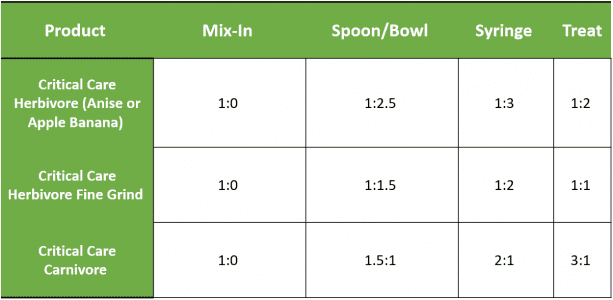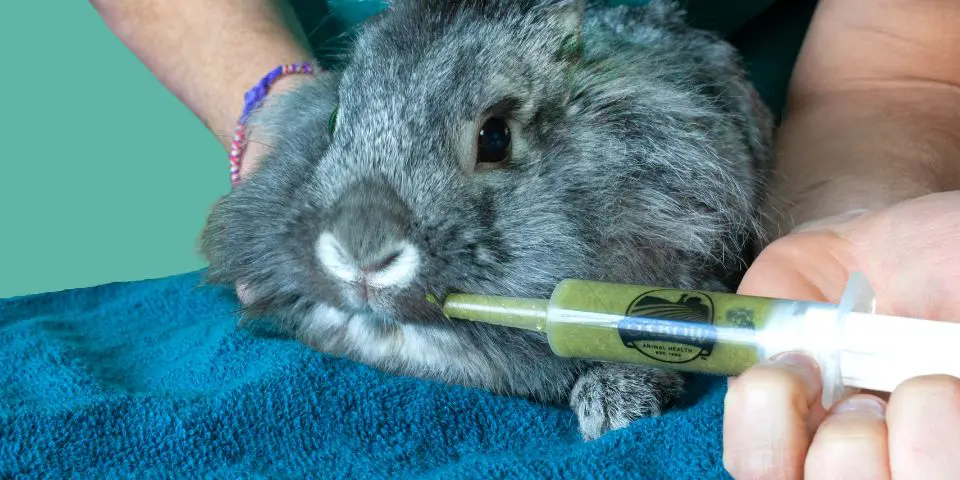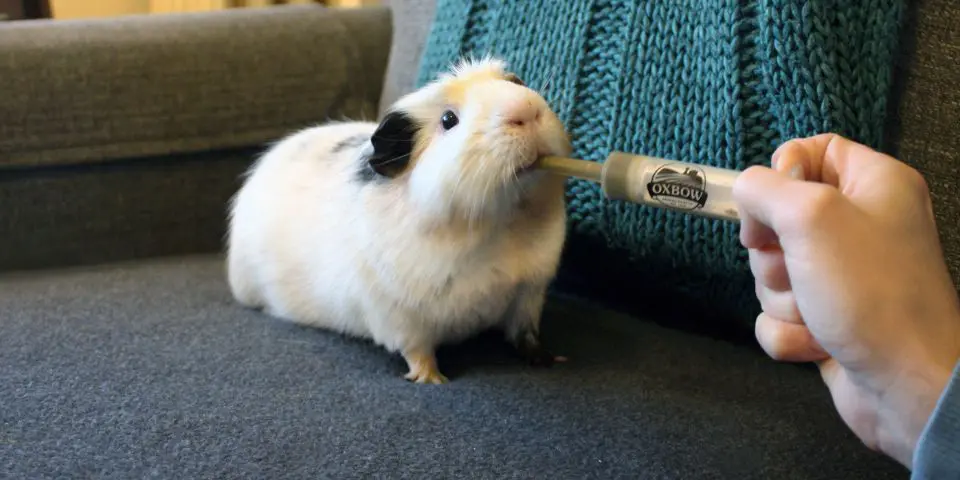Authors: Dr. Cayla Iske and Dianne Cook, LVT
Updated: May 7, 2025
As a pet parent, you’re no doubt familiar with everyday nutrition in the form of hays, fortified foods, and healthy treats. But, what about those unexpected, more critical situations that sometimes occur in a pet’s life? Some critical situations your pets might encounter could include:
- Injury
- Weight loss
- Additional illnesses
- Gastrointestinal issues
- General lack of appetite
- Recovery from surgery
Any time a pet is experiencing one of the above scenarios, the animal should always be taken to an experienced exotics veterinarian for a complete physical exam and potentially additional diagnostics to determine the underlying problem.
In some instances, your veterinarian may determine that a product specially-formulated to provide a complete diet in times of illness or convalescence (such as Oxbow’s Critical Care) may be appropriate to improve your pet’s health and assist in assisted feeding.
Getting to Know Critical Care
There are three distinct formulations in the Critical Care line:
All three formulas are designed to meet the unique nutritional needs of their intended species – herbivores (rabbits, guinea pigs, chinchillas, tortoises, iguanas, and others), carnivores (ferrets, cats, hawks, monitors, snakes, and others), and omnivores (bearded dragons, rats, hedgehogs, chickens, reptiles, and others).
Critical Care – Herbivore comes in three flavors, including anise, apple & banana, and papaya to stimulate your animal’s appetite. These are commonly used as recovery food for guinea pigs, rabbits and other small pets who need a boost.
In these times when animals can’t or won’t eat, Critical Care products can be mixed with water and fed to aid in recovery by providing complete nutrition in a nutrient-dense format.
Why is Critical Care Only Available Through My Veterinarian?
You may wonder, “Why is Oxbow Critical Care hard to find?” The answer is that your veterinarian is the only appropriate expert to determine if Oxbow’s Critical Care products are appropriate for your pet’s current condition. In some cases, symptoms like a guinea pig not eating may point to deeper issues that only diagnostics can uncover.
Without a proper diagnosis, your pet runs the risk of getting worse despite receiving nutritional support. That’s why Oxbow Critical Care Sachet and other Critical Care formats are most often distributed through vet clinics.
Different Ways to Offer Critical Care to Your Pets
One of the biggest benefits of Critical Care is its versatility. Depending on your animal and their willingness to eat, the feeding method can be adjusted. Common feeding methods include:
- Sprinkle dry as a top dressing
- Combine wet with pet’s food
- Offer wet in a bowl or by spoon
- Syringe or tube feed (for assisted feeding)
Offer Critical Care as a Top Dressing
In some cases, offering Critical Care can be as simple as sprinkling the dry powder on your animal’s usual food. This may even be a good addition to your pet emergency kit, especially if your pet is recovering or showing signs they won’t eat.
Combine Critical Care with Your Pet’s Existing Food
You can also mix Oxbow Critical Care Herbivore with water and stir it into your pet’s food. This is especially helpful if your vet recommends Oxbow Critical Care Papaya, which many animals find more palatable.
Offer Wet in Bowl or by Spoon
If your pet is still showing interest in eating but avoids their usual food, mixing Critical Care into a paste can be an easy and effective way to support a complete diet.
Syringe or Tube Feeding
For pets who won’t eat at all, assisted feeding may be necessary. You can use Critical Care for syringe feeding. Always follow dosage guidelines on the label—these can also help answer questions like “How often should you feed Critical Care to a rabbit?” The answer varies based on weight, condition, and species.
Tube feeding is most often conducted by your veterinarian, but you may be asked to syringe feed your animal once they leave the vet’s office. This may seem intimidating if you’ve not done it before, but there are some tips and tricks to make it easier.
Syringe Feeding Tips and Tricks
Use a syringe with the largest tip possible.
This will help prevent clogging, helping you avoid mess and frustration in the process. Feeding syringes with a large, smooth opening made specifically for administering gruels or Critical Care-type products are typically most effective. Most veterinary hospitals will have these syringes on hand or can order them upon your request.
Mix the dry product and water in a bowl and draw product up through the syringe.
If the product seems overly thick during mixing, you can add additional water to achieve a thinner consistency. The extra water also provides the added benefit of additional hydration. Though many pet parents take the plunger out of the syringe to “spoon” the mixture in through the top, you can actually “suck up” the product from the bowl.
Find the right “flavor fit” for your pet
If you are having difficulty syringe feeding or your animal doesn’t like the anise or apple banana flavor, you may want to request Critical Care Fine Grind (papaya flavor) from your veterinarian. Fine Grind provides the same nutritional profile as our anise and apple-banana products but is ground into an ultra-fine powder, which often makes administration of the product a bit easier.
Avoid slick surfaces and administer from a stable position
Many pet parents find it easiest to syringe feed their kiddos while sitting. This allows their little ones to securely sit on their lap or the floor in front of them. Others find it easiest to stand with their pet positioned on a table or countertop.
Regardless of the surface, it is important to remember that slick surfaces should be covered with something that will provide traction, so your pet doesn’t slip and increase the risk of injury. If you opt to feed on a counter or table, it is essential that you keep a gentle, yet secure hold on your pet to prevent them from startling and bolting off the surface.
Aspire Not to Aspirate
- Remain relaxed and gentle during syringe feedings. Assist feedings can be stressful for all involved, so speaking softly and continually reassuring your pet throughout the feeding can help make the experience as positive as possible.
- You may choose to gently wrap them in a towel. The act of receiving nourishment from a plastic syringe is unnatural and some pets will instinctually resist no matter how tasty the food. Wrapping them in a towel can provide a calming effect and make them easier to handle.
- Always keep your pet in a natural position during syringe feeding. All four feet should be in contact with the ground, and their spine should be in a natural, neutral position.
- Keep your pet’s natural line of sight in mind. Many prey species have laterally placed eyes, leaving them with a blind spot directly in front of the nose. So, try to avoid touching their nose or prying open their incisors with the syringe. Instead, insert the tip of the syringe into the side of the mouth, in the space behind the incisors/canines and in front of the molars.
- Administer very small amounts at a time, aiming for the center of the mouth and not the back of the throat.
- Don’t rush! Remove the syringe between mouthfuls to allow your pet time to chew and swallow. Forcing too much food into your pet’s mouth or not allowing them time to swallow is the most common cause of aspiration. Additionally, if your syringe clogs in the middle of a feeding, remove the syringe from your pet’s mouth and dislodge the clog before continuing the feeding.
- Practice makes perfect! Until you get the hang of syringe feedings, practice before feeding your pet by loading a syringe with a small amount of mixed Critical Care and testing how much pressure is required to get the desired amount of food to come out.
Don’t Let the Leftovers Go to Waste!
If you’ve got leftover Oxbow Critical Care and your vet gives the OK to stop assisted feeding, you can repurpose it into small, no-bake treats by forming and drying it overnight. Just avoid baking, which may reduce nutrient content.
Critical Care can be mixed with water, formed into shapes, and left out to dry overnight to create treats for your little ones. While you may want to bake the treats, it is best not to expose them to such high heat to keep the vitamins and other nutrients from degrading. These treats can be stored for 1-2 days and are a great way to get creative to provide nutritional enrichment for your pet.

How to Store Critical Care
- Mixed product: use within 24 hours
- Opened bags:
- Oxbow Critical Care Herbivore and Omnivore: Store sealed at room temp for 30 days
- Oxbow Critical Care Carnivore: Store in fridge and use within 7 days
- Unopened: Up to 2 years in a cool, dry location
- Avoid freezing to protect vitamin stability
Need to restock? Many pet parents search for Oxbow Critical Care near me or Oxbow Critical Care where to buy, and while your vet is the best source, you may also find Oxbow Critical Care Sachet options online or through specialty retailers.
Critical Care: There for Pets in Life’s Critical Situations
Whether you’re dealing with a guinea pig not eating, a post-op bunny, or a ferret in need of a complete diet, Oxbow Critical Care has been helping pets recover for over 20 years. Keep it on hand as part of your pet emergency kit and remember, these scientifically formulated blends support your pet’s recovery when they need it most.



